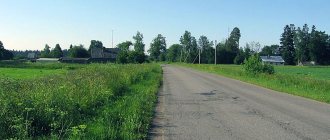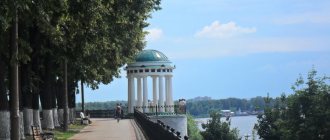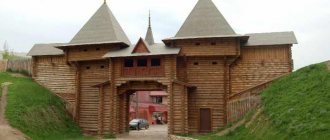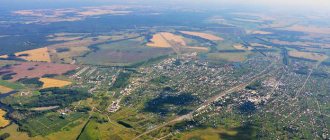This term has other meanings, see Suraj (meanings).
| City Suraj Coat of arms |
| A country | Russia, Russia |
| Subject of the federation | Bryansk regionBryansk region |
| Municipal district | Surazhsky |
| urban settlement | Surazhskoe |
| Coordinates | 53°01′00″ n. w. 32°24′00″ E. d. / 53.01667° n. w. 32.40000° E. d./53.01667; 32.40000 (G) [www.openstreetmap.org/?mlat=53.01667&mlon=32.40000&zoom=12 (O)] (Z)Coordinates: 53°01′00″ N. w. 32°24′00″ E. d. / 53.01667° n. w. 32.40000° E. d./53.01667; 32.40000 (G) [www.openstreetmap.org/?mlat=53.01667&mlon=32.40000&zoom=12 (O)] (I) |
| Chapter | Rykov Yuri Vitalievich |
| First mention | 17th century |
| Former names | Surazhichi, Surazh-on-Iputi |
| City with | 1781 |
| Square | 12.39 km² |
| Center height | 160 |
| Population | ↘11,089[1] people (2016) |
| Density | 935 people/km² |
| National composition | Russians, Belarusians, Ukrainians and others |
| Confessional composition | Orthodox and others |
| Names of residents | surazhan, surazhanin, surazhanka |
| Timezone | UTC+3 |
| Telephone code | +7 48330 |
| Postcode | 243500 |
| Vehicle code | 32 |
| OKATO code | [classif.spb.ru/classificators/view/okt.php?st=A&kr=1&kod=15254501 15 254 501] |
Audio, photo and video
on Wikimedia Commons
Suraj
- a city (since 1781[2]) in Russia, the administrative center of the Surazhsky district of the Bryansk region.
By Order of the Government of the Russian Federation dated July 29, 2014 No. 1398-r “On approval of the list of single-industry towns,” the city was included in the category “Single-industry municipalities of the Russian Federation (single-industry towns) in which there are risks of worsening the socio-economic situation”[3].
Story
According to unconfirmed reports, Surazh was first mentioned at the beginning of the 17th century. Originally it was a small village of Surazhichi
, part of the Mglinsky hundred of the Starodub regiment of the Hetmanate.
In 1781, with the abolition of the regimental-hundred system of the Hetmanate, the village of Surazhichi was transformed into a district town (original name: Surazh-on-Iputi
). By decree of June 4, 1782, the city was granted a coat of arms, which depicts “a bush of ripened hemp in a golden field, as a sign of the abundance of this plant, which residents trade with.”
In 1781-1796 - the center of the Surazh district as part of the Novgorod-Seversky governorship[2]. From 1797 to 1801 - a provincial town in Mglinsky district as part of the Little Russian province, and in 1801-1802 - as part of the Chernigov province. On February 27, 1803, it was restored to the rights of a district town, the center of the Surazh district as part of the Chernigov province.
In 1919, Surazhsky district was transferred to the newly formed Gomel province, and in 1921 the district center was moved from Surazh to Klintsy, and therefore the district became known as Klintsy. In 1926 it was transferred to the Bryansk province. Since 1929 it has been a regional center.
Map
| Surazh: cards |
Surazh: photo from space (Google Maps) Suraj: photo from space (Microsoft Virtual Earth)
| Suraj. Nearest cities. Distances in km. on the map (in brackets along roads) + direction. Using the hyperlink in the distance , you can get the route (information courtesy of the AutoTransInfo website) | |||
| 1 | Unecha | 26 (24) | SE |
| 2 | Gordeevka | 29 (65) | Z |
| 3 | Mglin | 30 (36) | IN |
| 4 | Klintsy | 31 (32) | YU |
| 5 | Zaimishche | 33 () | YU |
| 6 | Red Mountain | 53 (91) | Z |
| 7 | Starodub | 54 (55) | SE |
| 8 | Novozybkov | 62 (75) | SW |
| 9 | Kletnya | 68 (97) | NE |
| 10 | Pochep | 70 (80) | IN |
| 11 | Klimovo | 71 (89) | YU |
| 12 | Ershichi (Smolensk region) | 76 (233) | WITH |
| 13 | Fire | 76 (88) | SE |
| 14 | Zlynka | 78 (95) | SW |
| 15 | Zhiryatino | 91 (162) | IN |
| 16 | Shumyachi (Smolensk region) | 93 (233) | WITH |
| 17 | White Birch | 101 (155) | SE |
| 18 | Trubchevsk | 103 (120) | SE |
| 19 | Zhukovka | 105 (148) | NE |
| 20 | Dubrovka | 105 (149) | NE |
| 21 | Roslavl | 107 (197) | WITH |
| 22 | Vygonichi | 111 (134) | IN |
| 23 | Rzhanitsa | 111 (167) | NE |
| 24 | Rognedino | 115 (163) | NE |
| 25 | Glinishchevo | 116 () | IN |
| 26 | Seltso | 119 (171) | IN |
a brief description of
Located on the river. Iput (Dnieper basin), 177 km southwest of Bryansk. Railway station.
Territory (sq. km): 10
Information about the city of Surazh on the Russian Wikipedia site
Historical sketch
In the 17th century mentioned as the village of Surazhichi, later a settlement. Since 1781, the district town of Surazh-on-Iput of Novgorod-Seversky governorship, in 1796-1802. in the Little Russian province. Since 1797, the name Surazh was adopted. Since 1802 in the Chernigov province.
There is a possible connection between the name and the Russian dialect suroshka, surozhka “damp, low-lying, wooded area.” From the base of the term surozh-, using the suffix -ichi, the primary form of the oikonym Surazhichi was formed, indicating the inhabitants of this wetland.
In 1856, in the district town of Surazh, Chernigov province, there was 1 church, 139 houses, 43 shops.
In 1894, a cardboard factory was built in the city, in the 1920-30s. the factory was expanded.
During the Great Patriotic War of 1941-45, Surazh was occupied by Nazi troops on August 17, 1941. It was liberated on September 25, 1943 by troops of the Bryansk Front during the Bryansk operation.
Economy
Cardboard, clothing factories. Brickworks. Fruit and vegetable plant, butter and cheese plant, bakery.
In the Surazhsky region, potatoes, rye, barley, oats, vegetables (carrots, cabbage), and fodder beets are grown. Cattle, sheep, and pigs are raised.
Peat and gravel deposits.
Main enterprises
LIGHT INDUSTRY
JSC "Surazhanka"
243500, Bryansk region, Surazhsky district, Surazh, st.
Belorusskaya, 37 Offers:
Women's winter coats, demi-season coats, men's cotton jackets
Museums, galleries, exhibition halls
Surazh Museum of Local Lore 243500, Bryansk region, Surazhsky district, Surazh, st. Lenina, 73
Architecture, sights
8 km from Surazh, in the village of Lyalichi, are the remains of the palace complex of Count P.V. Zavadovsky, favorite of Catherine II (1780-90s; project by architect G. Quarenghi).
| Population by year (thousands of inhabitants) | |||||||
| 1856 | 3.1 | 1989 | 12.6 | 2006 | 11.8 | 2015 | 11.2 |
| 1897 | 4.0 | 1992 | 12.8 | 2007 | 11.8 | 2016 | 11.1 |
| 1926 | 5.8 | 1996 | 13.0 | 2008 | 11.8 | 2017 | 11.0 |
| 1931 | 5.9 | 1998 | 12.9 | 2010 | 11.7 | 2018 | 10.9 |
| 1939 | 9.0 | 2000 | 12.8 | 2011 | 11.6 | 2019 | 10.8 |
| 1959 | 8.5 | 2001 | 12.7 | 2012 | 11.6 | 2020 | 10.7 |
| 1970 | 10.3 | 2003 | 12.0 | 2013 | 11.7 | 2021 | 10.6 |
| 1979 | 10.6 | 2005 | 11.9 | 2014 | 11.2 | ||
Attractions
In the central part of Surazh, individual buildings dating back to the late 19th and early 20th centuries have been preserved. A unique symbol of the city can be called a small but very elegant chapel-tomb, built in 1907 in the city center by order of the local nobleman Ivan Isaev over the grave of his untimely departed wife Elena. In popular memory, the chapel is associated with the more famous family of Surazh nobles, the Iskritskys, which is why in literature today it is often referred to as the “chapel-tomb of the Iskritskys.”
The picturesque banks of Iput near Surazh are a favorite vacation spot for townspeople.
10 km east of the city is the village of Lyalichi - the former estate of Count P.V. Zavadovsky, where the estate palace and the majestic Catherine Church (the architect of both projects was Giacomo Quarenghi), as well as a badly neglected English-style park surrounding the estate, are partially preserved.
Surazh on the map of Russia
You can find Surazh on the map and get directions using your navigator using the coordinates (53.013891, 32.393043). In the north, 14 km away, there is the border with the Republic of Belarus, in the east - Mglin, in the west - the village of Gordeevka, in the southwest - Klintsy, in the south - Unecha.
Economy
The city-forming enterprise of Surazh is the industrial cardboard factory of JSC Proletary. Due to the decisive role of the factory in the city’s economy, in December 2009 Surazh was included in the list of single-industry towns by the Ministry of Regional Development. In 2011, Surazh was the first of the single-industry towns in the Bryansk region to develop and submit for approval to the Ministry of Regional Development a comprehensive investment plan (IIP) for the development of the single-industry town.
Other notable enterprises in the city’s economy include Surazhmolprom OJSC, the Surazh branch of Khlebogor LLC, and the Surazhanka clothing factory.
Suraj
(Bryansk region)
OKATO code:
15254501
Founded:
beginning.
17th century City since:
1781 City of district subordination (Surazhsky district, Bryansk region)
Center:
Surazhsky district
Telephone code (reference phone)
| 48330***** | — |
Deviation from Moscow time, hours:
0
Geographic latitude:
53°01′
Geographic longitude:
32°24′
Altitude above sea level, meters:
160 Sunrise and sunset times in the city of Surazh
Links
- Surazh, district town of Chernigov province // Encyclopedic Dictionary of Brockhaus and Efron: in 86 volumes (82 volumes and 4 additional). - St. Petersburg, 1890-1907.
The most important settlements Klintsy • Surazh • Mglin • Unecha • Svyatsk • Ardon • Usherpie • Gordeevka • Krasnaya (Popova) Mountain Surazhsky district →
Klintsovsky district
→
Klintsovsky district
Suraj is older than it is thought!
Surazh is one of the ancient cities of the Bryansk region. This is evidenced by the Surazh settlement, which occupies the right indigenous bank of the Iput. Based on finds in the cultural layer, archaeologists attribute the settlement to the New Stone Age.
A large family of the Slavic Radimichi tribe lived here. They called their settlement Suradichi. In the 13th century the settlement was deserted. In the upper part of the horizon of the cultural layer there are no traces of human activity. Continuous alluvial sand. Then again in the uppermost layer there are many remains of human life. Today we can only guess why the settlers left here. I think that the Mongol-Tatar invasion of Rus' played a major role in this.
In the 14th century the settlement was revived again. Rich Moscow merchants, the Surozhites, founded their trading colony here, called Surazhichi. Merchants traded hemp with Byzantium, which is confirmed by three gold Byzantine coins on the ancient coat of arms of Surazh.
Since the pre-Christian era, the people of Surozh lived in Crimea in their capital-fortress Surozh (now Sudak - author). The people of Surozh at that time were called Taurians, since they lived on the peninsula, since ancient times called Tauria.
Researcher A. Asov, a specialist in runic writings, analyzing the “Veles Book” - a collection of legends of the Slavs, discovered that “the Taurians - Surozhians lived in the Crimea for two thousand years and were Slavs, for they considered themselves the children of Dazhdbog and the grandchildren of Veles” (Dazhdbog-Slavic the god of the sun, and Veles the god of cattle. - author).
Recent excavations at the site of ancient Surozh have confirmed that the ancient Surozhians are a Slavic tribe. Archaeologists have discovered the remains of a fortress wall, decorated with sanctuaries of Slavic pagan deities.
In the 14th century, the Surozh people were ousted from Crimea by the Ottomans. The people of Surozh moved to the Bryansk region, Moscow, Belarus, and Ukraine, where they founded their own trading colonies. With the fall of Byzantium in 1453, trade with it ceased. The people of Surozh left Surazhichi and the settlement disappeared again, only to be reborn at the beginning of the 17th century. Not far from the former Surazhichi, A. Esimontovsky founded a monastery in 1720. Surazhichi was also mentioned in 1723, in the Little Russian population census.
So, the first mention of our settlement dates back to 1720. This should be considered the year of Surazh’s founding, since there are no other documents. Accepted in historical science. On the pylon at the entrance to Surazh from Unecha it is written: “... founded in 1781. But this is not true. This year the village was awarded the title of city, and these are completely different concepts. Ten years ago in Voskhod I already raised the issue of correcting the error, but, alas, I did not receive understanding from the authorities. But historical justice needs to be restored. We should be proud of the antiquity of our city, and not be Ivans who do not remember their kinship.
(The material is based on the following historical documents: Grigory Esimontovsky. Geographical sketch of the Starodubsky regiment. Description of the district. Kiev. 1845; Alex. Lazarevsky. “Description of old Little Russia” vol. I “Starodubsky regiment”. Kiev 1889, p. 320 ).
From the editor.
When this material was ready for publication, M. Mehedov called the editorial office with good news. Analyzing his historical archive, he turned to the historical “Essay on the city of Chernigov and its region in ancient and modern times” (Kyiv, 1846, p. 11). And he quoted the following: “... On December 1, 1618, according to the Deulin truce with Poland, Russia lost the territory of Severshchina with the cities of Starodub, Novozybkov, Mglin, Surazhichi, etc.” I am convinced, said Mikhail Ivanovich, that if it were possible to delve into the ancient trade documents of the Surozh merchants, and this is quite possible, of course, with the help of the district authorities, the district archive, then the year of the founding of the city of Surozh would move back even further. But for now, 383 years is a date that every Surazhan can be proud of.
Mekhedov, M. Surazh is more ancient than believed // Voskhod.-2001.-October 26
Shouldn't we be proud of this?
2003 marks the 385th anniversary of the founding of Surazh and the 200th anniversary of the Surazh district. If you look at the “Essay on the city of Chernigov and its region in ancient and modern times (Kiev, 1846, p. 11), you can read that in 1618 the cities of Severshchina - Starodub, Novozybkov, Mglin, the town of Surazhichi - became part of Poland and so on. In 1635, the town of Surazhichi became part of the Polish Vitebsk Voivodeship. By the way, all local historians of the region classify Surazhichi as one of the ancient cities of Russia. In 1781, due to the division of Little Russia into Chernigov region and Novgorod-Severshchina, Surazh was given the status of a city. In 1797, the city of Surazh became a provincial town, and in 1803 it was appointed a district town of the Chernigov province (See Domontovich, Statistical description of the Chernigov province, St. Petersburg, 1865, p. 632, as well as the journals of the Surazh district zemstvo: meetings for 1912 Chernigov, building 3). The Surazhsky district included 15 volosts, covering now the Krasnogorsky, Gordeevsky, Klintsovsky, part of the Novozybkovsky districts, including Usherpie, and the Surazhsky district. The population of the county was 200 thousand people.
In 1921, the Gomel Provincial Executive Committee adopted a resolution to abolish the Surazh district and move the center to the city of Klintsy. Surazhsky district was conditionally part of the Gomel province since February 1919.
On June 16, 1929, Surazh again became a regional center, first of the Western Region (Gabo, f. 1097. o. 1, f. 328.l 3-4), then of the Oryol Region, and in 1944 - of the Bryansk Region.
In 1963, on January 14, the “reformer” Nikita Khrushchev consolidated the districts. Surazhsky was divided into two parts - industrial and agricultural. After Khrushchev was removed from power on January 12, 1965, Surazh again became a regional center, which it remains to this day.
I have already mentioned more than once from the pages of the regional newspaper the main of the above dates and events. And now I come back to this again. Why? Look at the beginning of this note: next year our city turns 385 years old. But the inscription on the pylon at the entrance to Surazh from Unecha states otherwise: “Surazh was founded in 1781.” Once again (for the umpteenth time) I will repeat that this year our settlement received the title of city. And the year of foundation or birth of a city, town, or village is considered to be the year in which it is first mentioned in chronicles or other historical documents.
I think that such an attitude towards my hometown is unfair. Perhaps not much needs to be done to correct this injustice. Perhaps the deputies should simply make the appropriate decision and replace the numbers on the pylon? Perhaps we need a grassroots initiative for this? So I am ready to present all the documents necessary for making a decision, as well as an appeal from a number of citizens. The 400th anniversary of Surazh is not so close yet - 15 years, but with the way the authorities are reacting to my appeals, it is clear that this period will not be enough to bring the dates into line with historical facts,
Mekhedov, M. Shouldn’t we be proud of this // Sunrise. - 2002. - December 27
Plus 163 years!
For more than two years, the district newspaper raised on its pages the issue of restoring justice regarding the true “age” of our city. And for many more years, the former history teacher, local historian M.I. Mekhedov sought the same thing. Our joint efforts only led to the fact that almost a year ago, a special commission was created under the regional Council of People's Deputies to establish the year of foundation of Surazh. Apparently, none of the evidence provided about its first mention in historical documents turned out to be convincing for the commission, and the solution to the issue was postponed indefinitely. But finally, historical justice has triumphed, for which, on behalf of all Surazhan residents, many thanks to the city deputies. The twelfth session of the City Council on June 21, 2006, based on historical data and in accordance with current legislation, decided to consider the year 1618 as the founding year of Surazh! It is difficult to overestimate the historical significance of this event, which adds pride to everyone who sincerely loves their city - after all, it is much older than was thought! As we celebrate 225 years this year since Suraj was granted city status, we can now begin to prepare to celebrate its 390th anniversary in two years.
Plus 163 years // Voskhod.-2006.-June 30
Russian Federation
Bryansk region
Council of People's Deputies
Solution
12th meeting of the Council of People's Deputies of the city of Surazh
1st convocation
About establishing the year
foundation of the city of Surazh
from 21.06. 2006 No. 46
Having considered and discussed the proposals of the head of the city of Surazh Sivakov N.P. “On establishing the year of foundation of the city of Surazh”, based on historical data and in accordance with current legislation Council of People's Deputies
DECIDED:
Set 1618 as the year of foundation of the city of Surazh
The head of the city N.P. Sivakov
Work plan
MBUK "Surazh regional inter-settlement library"
to the 400th anniversary of the city of Surazh
(2016 – 2022)
2016
| The content of the work | Form carrying out | date carrying out | Responsible |
| “The streets of our city are named after them” | exhibition-trip | August | district library |
| "About the land where you were born" | local history hour | September | district library |
| “I glorify my beloved city...” | open-air literary courtyard | September | district library, rural branches |
| “We are proud of the history of the region” | participation in the competition “10 compelling reasons to come visit us”, announced by the regional newspaper “Voskhod” | September | district library, rural branches |
| “Leafing through the book of the city” (native land in the works of writers and poets) | virtual literary tour of the favorite places of Surazh writers and poets | December | district library, |
2017
| “Father's land. Chronicle of Vanishing Villages" | local history project | all period | district library, rural branches |
| “We are part of the country, we are a corner of Russia” | exhibition - panorama | January December | district library |
| "Stages of the Glorious Path" | competition for the best chronicle of the village among the libraries of the Surazh district | January December | district library, rural branches |
| “I live in this city, I know this city” | quiz | January | district library |
| "With love for my beloved city" | virtual trip to the historical places of your hometown | February | district library |
| "Literary Surazh" | virtual trip to the literary places of the Surazh region | March | district library |
| "The Legendary Generation" | theme evening dedicated to the Surazhans - participants in the great battles of the Great Patriotic War | April | district library |
| "We remember!" – about the Surazh underground organization during the Great Patriotic War | booklet | May | district library |
| "Entered Immortality" | evening - requiem for partisans and underground fighters of the Surazh region | June | district library |
| “Those who glorified the Surazh region with their work” | virtual exhibition | June - September | district library |
| “We are proud of you!” | evening meeting with the Hero of Socialist Labor N.Ya. Khomyakova | December | district library |
| "Our Famous Countrymen" | cycle of literature exhibitions | September - December | district library, rural branches |
| “Father's land. Chronicle of Vanishing Villages" | local history conference | December | district library |
2018
| “This is our story line. History of the Surazhsky district in facts and faces" | district action | all period | district library, rural branches | ||
| "My city…" | exhibition – vernissage of historical photographs | all period | district library | ||
| "People. Events. Data" | opening of the anniversary year, installation of a tear-off calendar counting down to the start of the celebration of the 400th anniversary of the founding of the city of Surazh | January | district library, rural branches | ||
| “Happy Birthday – beloved city!” | multimedia presentation competition | February | district library | ||
| “Surazh – the city of masters” | exhibition of creative works | March | district library | ||
| “We were lucky to be born here” | series of virtual excursions | April May | district library | ||
| “Good wishes to your beloved city” | promotion | May | district library | ||
| “Declaration of love for our native land!” | poetry platform | June | district library | ||
| “In the dawn of war” - dedicated to the partisans and underground fighters of the Surazh region | theme evening | June | district library | ||
| “History of the native city in questions and answers” | quiz | June | district library | ||
| “Our beloved city is near and dear to us” | booklet | August | district library | ||
| “Suraj. Stages of formation" | local history conference | September | district library, rural branches | ||
| "Suraj: Dates. Events. Data" | Presentation of a collection of documents | November December | district library | ||
Excerpt characterizing Suraj
But a few days before leaving Moscow, touched and excited by everything that was happening, the Countess, calling Sonya to her, instead of reproaches and demands, turned to her with tears and prayed that she, by sacrificing herself, would repay for everything. what was done for her was to break her ties with Nikolai. “I won’t be at peace until you give me this promise.” Sonya burst into tears hysterically, answered through her sobs that she would do everything, that she was ready for anything, but she did not make a direct promise and in her soul could not decide on what was demanded of her. She had to sacrifice herself for the happiness of the family that fed and raised her. Sacrificing herself for the happiness of others was Sonya's habit. Her position in the house was such that only on the path of sacrifice could she show her virtues, and she was accustomed and loved to sacrifice herself. But first, in all acts of self-sacrifice, she joyfully realized that by sacrificing herself, she thereby raised her worth in the eyes of herself and others and became more worthy of Nicolas, whom she loved most in life; but now her sacrifice had to consist in giving up what for her constituted the entire reward of the sacrifice, the entire meaning of life. And for the first time in her life, she felt bitterness towards those people who had benefited her in order to torture her more painfully; I felt envy of Natasha, who had never experienced anything like this, never needed sacrifices and forced others to sacrifice herself and yet was loved by everyone. And for the first time, Sonya felt how, out of her quiet, pure love for Nicolas, a passionate feeling suddenly began to grow, which stood above rules, virtue, and religion; and under the influence of this feeling, Sonya involuntarily, learned by her dependent life of secrecy, answered the countess in general, vague words, avoided conversations with her and decided to wait for a meeting with Nikolai so that in this meeting she would not free her, but, on the contrary, forever bind herself to him . The troubles and horror of the last days of the Rostovs’ stay in Moscow drowned out the dark thoughts that were weighing on her. She was glad to find salvation from them in practical activities. But when she learned about the presence of Prince Andrei in their house, despite all the sincere pity that she felt for him and Natasha, a joyful and superstitious feeling that God did not want her to be separated from Nicolas overtook her. She knew that Natasha loved one Prince Andrei and did not stop loving him. She knew that now, brought together in such terrible conditions, they would love each other again and that then Nicholas, due to the kinship that would be between them, would not be able to marry Princess Marya. Despite all the horror of everything that happened in the last days and during the first days of the journey, this feeling, this awareness of the intervention of providence in her personal affairs pleased Sonya. The Rostovs spent their first day on their trip at the Trinity Lavra. In the hotel of the Lavra, the Rostovs were allocated three large rooms, one of which was occupied by Prince Andrei. The wounded man was much better that day. Natasha sat with him. In the next room the Count and Countess sat, respectfully talking with the rector, who had visited their old acquaintances and investors. Sonya was sitting right there, and she was tormented by curiosity about what Prince Andrei and Natasha were talking about. She listened to the sounds of their voices from behind the door. The door of Prince Andrei's room opened. Natasha came out of there with an excited face and, not noticing the monk who stood up to meet her and grabbed the wide sleeve of his right hand, walked up to Sonya and took her hand. - Natasha, what are you doing? Come here,” said the Countess. Natasha came under the blessing, and the abbot advised to turn to God and his saint for help. Immediately after the abbot left, Nashata took her friend’s hand and walked with her into the empty room. - Sonya, right? will he be alive? - she said. – Sonya, how happy I am and how unhappy I am! Sonya, my dear, everything is as before. If only he were alive. He can’t... because, because... that... - And Natasha burst into tears. - So! I knew it! Thank God,” said Sonya. - He will be alive! Sonya was no less excited than her friend - both by her fear and grief, and by her personal thoughts that were not expressed to anyone. She, sobbing, kissed and consoled Natasha. “If only he were alive!” - she thought. After crying, talking and wiping away their tears, both friends approached Prince Andrei’s door. Natasha carefully opened the doors and looked into the room. Sonya stood next to her at the half-open door. Prince Andrei lay high on three pillows. His pale face was calm, his eyes were closed, and you could see how he was breathing evenly. - Oh, Natasha! – Sonya suddenly almost screamed, grabbing her cousin’s hand and retreating from the door. - What? What? – Natasha asked. “This is this, that, that...” said Sonya with a pale face and trembling lips. Natasha quietly closed the door and went with Sonya to the window, not yet understanding what they were saying to her. “Do you remember,” Sonya said with a frightened and solemn face, “do you remember when I looked for you in the mirror... In Otradnoye, at Christmas time... Do you remember what I saw?..” - Yes, yes! - Natasha said, opening her eyes wide, vaguely remembering that Sonya then said something about Prince Andrei, whom she saw lying down. - Do you remember? – Sonya continued. “I saw it then and told everyone, both you and Dunyasha.” “I saw that he was lying on the bed,” she said, making a gesture with her hand with a raised finger at every detail, “and that he had closed his eyes, and that he was covered with a pink blanket, and that he had folded his hands,” Sonya said, making sure that as she described the details she saw now, that these same details she saw then. She didn’t see anything then, but said that she saw what came into her head; but what she came up with then seemed to her as valid as any other memory. What she said then, that he looked back at her and smiled and was covered with something red, she not only remembered, but was firmly convinced that even then she said and saw that he was covered with a pink, exactly pink, blanket, and that his eyes were closed.
External links [edit]
- The murder of Surazh Jews during the Great Patriotic War on the Yad Vashem website.
| vteAdministrative divisions in the Bryansk region | ||
| Administrative center: Bryansk • Village. | ||
| Districts |
| |
| Cities and towns |
| |
| Urban settlements |
| |







